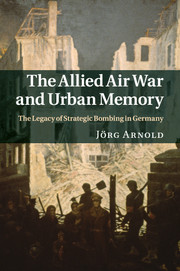Book contents
- Frontmatter
- Contents
- Illustrations
- List of Maps
- Preface
- Abbreviations
- Maps
- Introduction: a poem and an image
- 1 From experience to memory: the emergence of lieux de mémoire, 1943–1947
- Part I Commemorating death
- 2 ‘Soldiers of the Heimat’: commemorating the dead, 1940–1945
- 3 ‘In quiet memory’?: post-war memory cultures, 1945–1979
- 4 The return of the dead: the renaissance of commemoration, 1979–1995
- Part II Confronting destruction
- Part III Writing histories
- Appendices
- Bibliography
- Index
- References
3 - ‘In quiet memory’?: post-war memory cultures, 1945–1979
from Part I - Commemorating death
Published online by Cambridge University Press: 05 July 2011
- Frontmatter
- Contents
- Illustrations
- List of Maps
- Preface
- Abbreviations
- Maps
- Introduction: a poem and an image
- 1 From experience to memory: the emergence of lieux de mémoire, 1943–1947
- Part I Commemorating death
- 2 ‘Soldiers of the Heimat’: commemorating the dead, 1940–1945
- 3 ‘In quiet memory’?: post-war memory cultures, 1945–1979
- 4 The return of the dead: the renaissance of commemoration, 1979–1995
- Part II Confronting destruction
- Part III Writing histories
- Appendices
- Bibliography
- Index
- References
Summary
Introduction: a usable past?
Today, we remember all the dead whose lives were over so suddenly. We remember the dead whose graves we can adorn; we remember those who vanished without a trace and whose graves nobody knows. We remember the mourning relatives of those who were swept away by the storm of fire.
Seven years after the devastating air raid on Kassel and six years after his first commemorative service, Lutheran pastor Paul Velbinger returned to the subject of death under the bombs. In a memorial service that he held on 22 October 1950 in a makeshift church, Velbinger conceptualised the attack as an affliction, taking the rubble as evidence of God’s judgement as well as his grace. The Lutherkirche was not the only parish to mark the day by means of a special commemoration. It was joined by other Christian congregations across the city of Kassel. In the afternoon, 5,000 residents had gathered in the main cemetery in order to attend a secular memorial celebration that had been organised by the local branch of the Central League of Air Raid Victims (Zentralverband der Fliegergeschädigten).
- Type
- Chapter
- Information
- The Allied Air War and Urban MemoryThe Legacy of Strategic Bombing in Germany, pp. 97 - 140Publisher: Cambridge University PressPrint publication year: 2011



